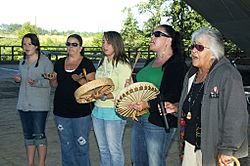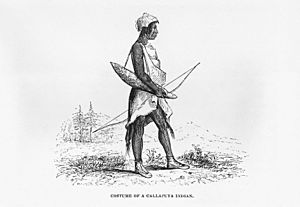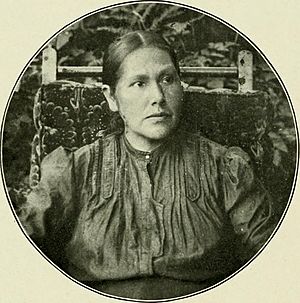Kalapuya facts for kids

Esther Stutzman, a Kalapuya elder, leads her daughters in a Kalapuya welcome song, 2009.
|
|
| Total population | |
|---|---|
| estimated 4,000 | |
| Regions with significant populations | |
( |
|
| Languages | |
| English language, formerly Kalapuya language |
The Kalapuya are a group of Native American people. They once had eight different groups, each speaking one of three similar languages. The Kalapuya tribes lived in the Willamette Valley in what is now western Oregon, United States. This area was surrounded by mountains and rivers.
Today, most Kalapuya people are part of the Confederated Tribes of the Grand Ronde Community of Oregon. Some are also members of the Confederated Tribes of the Siletz. Kalapuya descendants often marry people from other tribes in these groups. They are counted as part of the larger tribal numbers. Most Kalapuya descendants live on the Grand Ronde reservation.
Contents
Understanding the Kalapuya Name
The name "Kalapuya" has been spelled in many ways over time. You might see it written as "Calapooia," "Calapuya," "Calapooya," "Kalapooia," or "Kalapooya." These are all ways to refer to the same group of people.
The Kalapuya Language and Communication
The Kalapuya people spoke different forms of the Kalapuyan language. These languages are now known as part of the Oregon Penutian languages family.
The Kalapuya were not one single tribe. They were made up of eight separate groups. These groups were connected by three main language types: Northern Kalapuyan, Central Kalapuyan, and Yoncalla (also called Southern Kalapuya). People speaking these different types could usually understand each other.
A Catholic missionary named François Blanchet noted that many dialects were spoken. He also said that the Chinook jargon was used among the Kalapuya. This was a special trade language. It helped Native Americans and Europeans talk to each other for trading.
The Confederated Tribes of the Grand Ronde Community of Oregon now call this trade language Chinuk Wawa. They have a program to teach it to children. This helps new generations learn to speak their native language.
Kalapuya Social Life and Structure
Kalapuya groups were usually made up of large families. These families included related men, their wives, and children. They lived in a main village all year, especially during winter. In spring and summer, some family members would travel in smaller groups. They would gather seasonal foods and materials for making baskets.
Each group often had a single leader or chief. This person was usually the wealthiest man. The chief would help solve arguments and manage community debts, like those from gambling. They also provided food for celebrations.
Wealth and Social Classes
Like many tribes in the Pacific Northwest, the Kalapuya sometimes had slaves. Slaves were usually obtained through trade or as gifts. They were often people captured by enemy tribes during raids. Northern Kalapuya groups sometimes got slaves by conquering other groups.
Slaves were seen as a form of wealth. They could be traded for valuable items like beads, blankets, and canoes. Women and children were often preferred as slaves because they were easier to manage.
Slaves lived with the families who owned them. They worked alongside them on daily tasks, like collecting firewood and water. Slaves were often allowed to marry. They could even buy their freedom if they saved enough property or if a future spouse paid their owner.
Kalapuya society also had different classes based on wealth. Special religious leaders were another important group. These leaders were believed to have special powers for predicting the future or healing. They could come from any group, be male or female, and be free or enslaved.
Daily Life and Gender Roles
Kalapuya society had different jobs for men and women. Men were responsible for fishing, hunting, and warfare. They also made tools and built canoes. Women gathered and prepared the main plant foods that the Kalapuya ate. They also set up temporary camps and made baskets and other crafts.
During the summer, women would prepare food to store for the winter. They usually stayed in the main village for this task. Other women would go out to gather the foods from different areas.
Historic Kalapuyan Groups

Here are some of the Kalapuyan groups, named by their language:
- Northern Kalapuya:
- Tualatin, also known as the Atfalati, lived along the Tualatin River.
- Yamhill, lived along the Yamhill River.
- Central Kalapuya:
- Ahantchuyuk, lived along the Pudding River.
- Luckiamute, lived along the Luckiamute River.
- Santiam, lived along the lower Santiam River near Lebanon.
- Chepenefa, lived along the Marys River near Corvallis.
- Chemapho, lived along Muddy Creek.
- Tsankupi, lived along the Calapooia River.
- Mohawk, lived along the Mohawk River. (Note: These are not related to the Iroquoian-speaking Mohawk Nation from New York and Canada.)
- Chafan
- Chelamela, lived along the Long Tom River.
- Winefelly, lived along the Mohawk, McKenzie, and Coast Fork Willamette rivers.
- Yoncalla:
- Yoncalla, lived along the Umpqua River.
In 1849, Governor Joseph Lane estimated the populations of some tribes. He listed "Calipoa" with 60 people, "Tualatine" with 60, "Yam Hill" with 90, and "Lucka-mues" with 15.
Kalapuya History: Changes and Challenges
Historians believe the Kalapuya people moved into the Willamette Valley from the south. They likely pushed out earlier groups living there.
Each Kalapuyan group lived in specific areas along the Willamette, Umpqua, and McKenzie rivers. The Kalapuya were hunter-gatherers. Men fished and hunted, while women gathered nuts, berries, and roots. They used obsidian from the nearby mountains to make sharp tools and arrowheads.
Population Decline and Disease
Before Europeans arrived, the Kalapuya population may have been as high as 15,000 people. However, after contact with explorers and traders, many people died from diseases. Diseases like malaria and smallpox were common among Europeans. Native Americans had no natural protection against these new illnesses.
Some stories describe villages where everyone had died, showing how deadly these diseases were. In 1839, a missionary reported that diseases had greatly reduced the population. By 1849, Oregon's governor estimated only 60 Kalapuya people remained. Today, experts believe the number was closer to 600 at that time.
Agreements with the United States
The United States made two main sets of agreements, called treaties, with tribes in Oregon. These happened in 1851 and again from 1854 to 1855. The 1851 treaties were never officially approved by the government. However, the 1854–1855 treaties were approved and put into action.
In 1851, at a meeting in Champoeg, Santiam Kalapuya leaders spoke strongly about where they wanted to live. They wanted to keep their traditional lands near the Santiam River.
In 1854, in the Treaty of Calapooia Creek, the Umpqua and Kalapuyan tribes of the Umpqua Valley gave up their lands to the United States.
Then, in the Treaty with the Kalapuya, etc., signed in Dayton, Oregon in 1855, the Kalapuya and other Willamette Valley tribes gave up all the land around the Willamette River to the United States.
Life on Reservations
Most Kalapuya people were moved to the Grand Ronde Agency and reservation. Some were sent to the Siletz Reservation or other reservations. The Grand Ronde Reservation was set up in 1855. It was officially named the Grand Ronde Reservation in 1857.
Life on the reservation was hard. People from at least 27 different tribes were moved there, and some of these tribes had been enemies. At first, the reservation was managed by the United States Department of War. Later, the Bureau of Indian Affairs took over.
A Catholic missionary from Belgium, Rev. Adrien Croquet, started St. Michael's church at Grand Ronde. The Roman Catholic Church also opened a school there. This was a boarding school where children sometimes had to stay all year. Many children were later sent to off-reservation Indian boarding schools, like Chemawa Indian School. They were taught skills like blacksmithing, farming, and sewing.
Health and living conditions on the reservation were poor. Many people died. In the 1850s, about 1,000 people were moved to Grand Ronde. By 1900, only about 300 people were left.
Ending and Restoring Tribal Status
In the mid-1900s, the government wanted Native Americans to join mainstream society. Congress decided that some tribes were ready to end their special relationship with the government. All the Kalapuya groups and other western Oregon tribes lost their official tribal status in 1954. This was part of the Western Oregon Indian Termination Act.
This act ended their special connection with the federal government. The government sold most of the reservation lands and stopped providing services.
In the late 1900s, the Kalapuya and other tribes worked to bring back their Native American culture. The United States officially recognized the Confederated Tribes of the Siletz again in 1977. The Confederated Tribes of the Grand Ronde Community of Oregon regained their recognition in 1983.
The Kalapuya have often married people from neighboring tribes. Most of the estimated 4,000 Kalapuya descendants today are part of the Confederated Tribes of the Grand Ronde Community of Oregon. This community is working to bring back Chinuk Wawa, a trade language used by many tribes. They have a program to teach this language to children. They have been successful and are expanding the program through the eighth grade.



